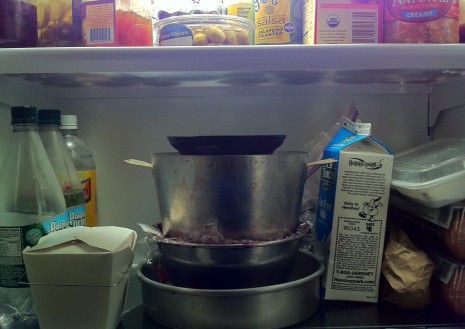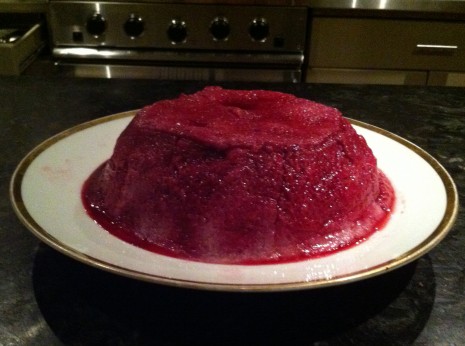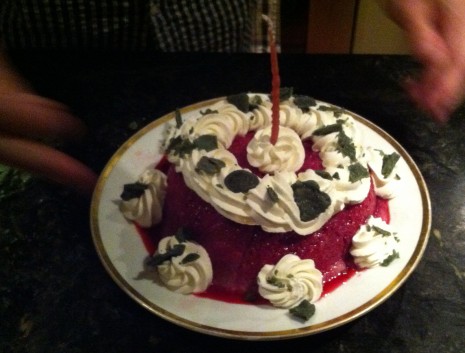A LATE-SUMMER PUDDING
You never know what you will find in a food stylist’s refrigerator. Take that of Rick Ellis, above. I had to ponder the contents for a minute before I figured it out. “You’re weighting a summer pudding!” I exclaimed. “Shh!” Rick replied. “It’s for Simon’s birthday.”
Simon Blake, a film and mixed-media director, and his wife, Nadine, two friends visiting from New Orleans, were holding court in the other room over plates of take-out Chinese food. They are two of the nicest and most interesting people on the planet.
“Because Simon is English, I wanted to make an English dessert for him,” Rick said. “How could I not make summer pudding? And it’s so simple.”
“You really want fresh currants for this, but there were none to be had,” he continued. “So in addition to raspberries, I used blueberries and blackberries. Call this a late-summer pudding.” He extricated the pudding from the fridge and removed the ballast, neatly stowed in a charlotte mold, that was compressing fruit and bread.
Then he inverted the pudding onto a serving plate. It looked very sure of itself and its place in the world.
Nigel Slater, writing about summer pudding in The Observer some years ago, explained that he ranks it “with Christmas pudding as one of the best recipes ever, except, of course, that the weather is usually better.” He continued, “It matters not one jot if you make it in a shallow dish, a pudding basin, or, charming this, in individual china dishes. What is important—no, essential—is the juice and how the bread soaks it up. This is your ‘essence.’ … The difference between a good pud and one that is utterly sublime is the juice that soaks into the bread. It is this—its flavour and sheer abundance—that will make or break this dessert.”
I had a feeling that Rick’s addition of blackberries was going to be a good one. Their complex, winey tartness would counter the sweetness of the other berries—a summer pudding is supposed to be tangy—and they intensified the brilliant color of the pudding as well.
I looked around for a jug of cream, for serving, but Rick, who can be unnervingly telepathic, forestalled me. “I know a summer pudding is traditionally served with cream, for pouring,” he said. “But this one needs to be a birthday cake.”
He snipped off the tip of a disposable pastry bag, filled it with whipped cream, and before I knew it, he had decorated the pudding with fat rosettes. “And I just happened to have some crystallized mint leaves in my pocket,” he added. Only a food stylist could get away with that line.
The great thing about a birthday summer pudding is that if it is as hot as blazes out or you suffer from F.O.F. (Fear of Flour), you don’t have to bake. There are no layers or frosting to worry about, yet there is still an inherent drama quotient. If the person you have made it for is English, he may get a little misty-eyed and nostalgic.
Be prepared for guests to crowd around as you cut enjoyably large servings. They will watch the jewel-colored fruit and its juices spill out and want a piece as soon as possible, even if they’re too polite to say so. One spoonful of the bright, fresh berry flavor is generally enough to reduce everyone to silence, the ultimate compliment.
Rick Ellis’s Late-Summer Pudding
“This is best made with local fresh fruit,” Rick said. “Berries bought at the grocery store may need a little more sugar or a little fresh lemon juice or zest to improve the flavor.” In making a summer pudding, you can waste lots of bread, trying to cut slices to fit the bowl uniformly. Rick froze his scraps for breadcrumbs, which is an excellent idea.
2 pints raspberries
½ pint blueberries
½ pint blackberries
1 loaf good white sandwich bread (Pepperidge Farm will do if you can’t buy a fresh loaf), sliced ½ inch thick
¼ cup sugar
¼ cup water
Freshly whipped cream, for serving
1. Pick over berries to remove leaves, stems, rotten ones, etc. Wash gently and let drain.
2. Trim the crusts off the bread. Line the bottom and sides of a 6- to 8-cup bowl (glass, stainless steel, or glazed ceramic) with slices of bread. They should fit tightly, with no gaps showing. Be sure to save enough slices to cover the pudding after you pour in the berry mixture.
3. In a medium saucepan, combine the sugar and water. Cook over medium heat until the sugar is dissolved. Add the berries, stir gently to combine, and cook 3 to 4 minutes. Remove from heat and let cool 10 minutes or so.
4. Pour the berries and liquid into the bread-lined bowl. (The mixture should come to slightly below the top edge of the bread slices.) Top with remaining slices of bread, again fitting them tightly together so no fruit is showing.
5. Put the bowl in a shallow dish to catch any juice, cover with plastic wrap, and top with a flat plate that fits inside the bowl. Put a heavy weight on the plate. Refrigerate at least 8 hours.
6. Run a thin blade around the edge of the pudding to loosen, then invert the bowl onto a serving plate. Rick did this very carefully, then gave the whole ensemble an encouraging little shake. Nothing happened. He gave the bowl a few sharp taps and then waited, bowl still upside-down on the plate. About 20 seconds later, the suction released and he lifted the bowl off the pudding. Ta dah! Serve with whipped cream.
Posted: September 4th, 2012 under people + places, recipes, summer.






Comment from Cynthia A.
Time September 5, 2012 at 4:28 am
Perfect English dessert! Bravo Mr. Ellis, and happy birthday Mr. Blake.